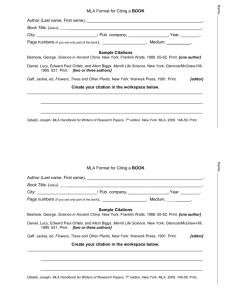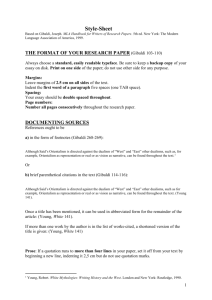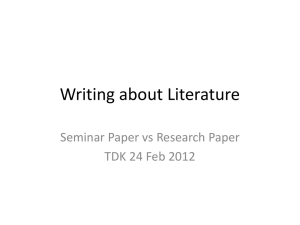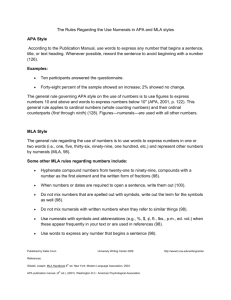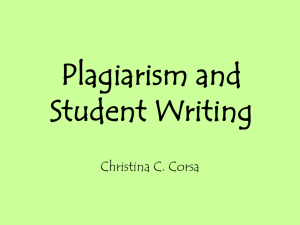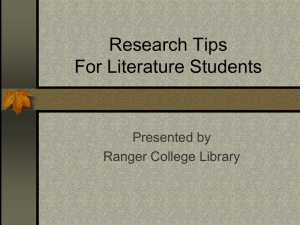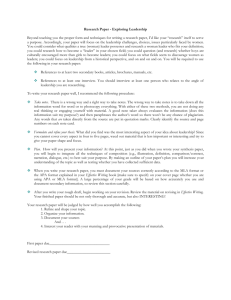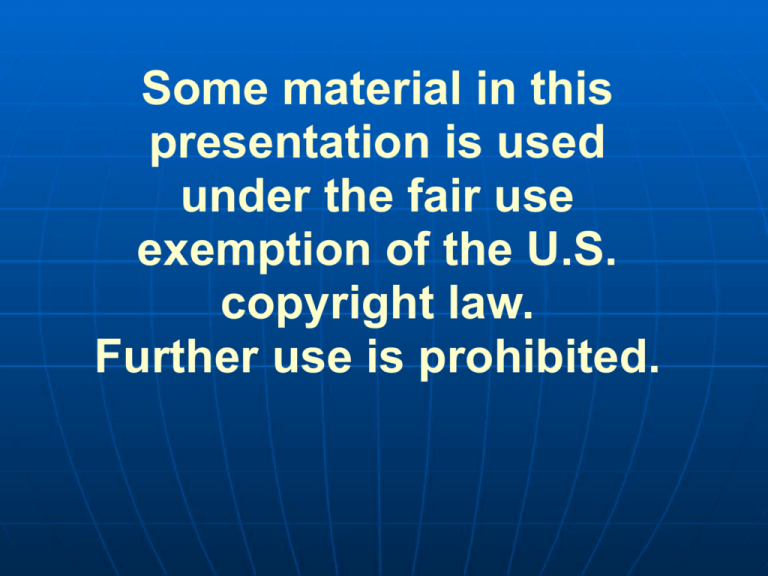
Some material in this
presentation is used
under the fair use
exemption of the U.S.
copyright law.
Further use is prohibited.
Plagiarism and
Copyright
- Or How I gave up “copy and paste”
and learned to cite responsibly!
Two reasons for this
PowerPoint
• To help you understand Plagiarism
• To show you how to keep from
plagiarizing when you do your
school projects
What, exactly, is
Tell me what you think
Plagiarism
• is claiming another
person’s work as your
own
APA Style (Gibaldi, 2003, p. 66)
MLA Style (Gibaldi 66)
Is plagiarism
Cheating?
What can be plagiarized?
Videos, too - -
Words Can be
plagiarized . .
So. . .What Else?
There’sm
usic,
and Lyrics
Two types of plagiarism:
• Intentional
Copying a friend’s work
Buying or borrowing papers
Cutting and pasting blocks
of text from electronic
sources without
documenting
o Media
“borrowing”
without documentation
o Web publishing without
permissions of creators
o
o
o
• Unintentional
o
o
o
o
Careless paraphrasing
Poor documentation
Quoting excessively
Failure to use your
own “voice”
You might be surprised to
learn
It even includes .
. ideas that have
been expressed
in a tangible
form
Really any creation can be
plagiarized
So. . .what’s a
person
supposed to do?
Hmmmmm
mm!!?!!
First, think about the information
you’re using when you do a project
...
Did you already
know the
information. . . or
Did you learn it
doing this project?
Hmmmmm
mm!!?!!
If you didn’t know it before -
Ask yourself:
“Does
someone else
deserve
credit?!?”
Hmmmmm
mm!!?!!
AND
“Is it my
responsibility to
give credit?”
If you are using materials
that belong to somebody
else . . . then, you must give
them credit!
“OK, so it’s my responsibility to
give credit . . . but
How in the world do I do that??”
Do You Remember seeing the
next slide before?
Plagiarism
is claiming another
person’s work as your
own
APA Style (Gibaldi, 2003, p. 66)
MLA Style (Gibaldi 66)
Plagiarism
is claiming another
person’s work as your
own
APA Style (Gibaldi, 2003, p. 66)
MLA Style (Gibaldi 66)
APA Style (Gibaldi, 2003, p. 66)
MLA Style (Gibaldi 66)
This statement was paraphrased from a book. I
didn’t want to plagiarize, so I’m going to give
credit. You can use either APA or MLA styles to
give credit.
Notice that this information was
placed directly with the paraphrased
information
Not just at the end of the project
in a bibliography.
APA Style (Gibaldi, 2003, p. 66)
MLA Style (Gibaldi 66)
APA Style (Gibaldi, 2003, p. 66)
MLA Style (Gibaldi 66)
This is Part I of how we give credit!
Giving credit with the information -within the project
It is called “Internal Citation”
Part II of giving credit involves making a
Bibliography.
Bibliographies are required if you are:
•
•
•
•
•
•
Writing a paper,
Making a poster,
Doing a PowerPoint
Making a video
Basically completing any assignment
Here’s an example . . .
Bibliography
“About Rick Riordan.” Rick Riordan. n.d. 15 February 2006
<http://www.rickriordan.com/>.
“BOINGG.WAV.” Free Sounds Files Archive. n.d. TNS Group, Inc. 25 February
2006 <http://www.freesoundfiles.tintagel.net/Audio/c-beeps/>.
Gibaldi, Joseph. MLA Handbook for Writers of Research Papers. 6th ed. New
York: The Modern Language Association of America, 2003.
But. . .
For now, we’re just mentioning
giving credit.
Don’t worry, you’ll learn more
about how to give credit in
another lesson!
Let’ talk about a relative
of plagiarism . . .
Copyright laws “protect the financial
interests of the creators, producers,
and distributors of original works.”
(Smaldino et al. 11)
When most people create
something – a book, music whatever
Guess what?!
They hope to make money
and support themselves!!
But, if people use those materials and
not pay for them,
They are robbing the artists,
authors, and others of their
livelihood!
Not only that, they are breaking
copyright laws!
Breaking copyright laws is called
Copyright Infringement
If caught, a person could face
tremendous fines, at the least!
You could be guilty of Copyright
Infringement
• Even if you are careful to not
plagiarize, you can still break
copyright laws!
Let’s say you want to use several
pictures of an artist’s work that you
found on Google images
All you need to do is
You decide it’s OK as long
copy and paste. It’s so as you give credit. You think
easy!
– “that way I won’t
plagiarize!”
You can only use those picture if the web
site tell you it is OK! If no permission – then
NO USE
1
(Gibaldi 74)
( 1”BOINNG.WAV” Free Sound File Archives . n.d. TNS
Group, Inc. 25 February 2006 www.freesounds.com.)
(Gibaldi 74)
Meet Texas Author, Rick Riordan
“Rick Riordan is the multiaward-winning author of the
Tres Navarre mystery series for
adults and the Percy Jackson
and the Olympians series for
children. . . . His adult fiction
has won the top three national
awards in the mystery genre”
(About www. rickriordan.com).
Permission
Written permission obtained to use
material from www.rickriordan.com/author.htm
What’s the big deal??
Is it really so important?
Well, let’s think . . .
Would it matter to you if someone
stole from you or cheated you?
Plus,
as for
knowing . . .
There is no pride in work that
isn’t your own!!
It’s your decision. On which
side of the line will you land?
Bibliography
“About Rick Riordan.” Rick Riordan. n.d. 15
February 2006
<http://www.rickriordan.com/>.
“BOINGG.WAV.” Free Sounds Files Archive. n.d. TNS
Group, Inc. 25 February 2006
<http://www.freesoundfiles.tintagel.net/Audio/c-beeps/>.
Bibliography
Gibaldi, Joseph. MLA Handbook for Writers of Research
Papers. 6th ed. New York: The Modern Language
Association of America, 2003.
“Plagiarism.” Oxford English Dictionary Online. 2006
Oxford University Press. University of North Texas
Electronic Resources, Denton, TX. 20 February 2006
<http://irservices.library.unt.edu/>.
Bibliography
Publication Manual of the American Psychological
Association. 5th ed. Washington D.C.: American
Psychological Association, 2002.
Smaldino, Sharon E., et al. Instructional Technology and
Media for Learning. 8th ed. Upper Saddle River, New Jersey:
Pearson Prentice Hall, 2005.
Bibliography
Tyre, Terrian. “Their Cheating Hearts.” District
Administration. Oct 2001: 32-35 Academic Search Premier.
EBSCOhost. University of North Texas Electronic
Resources, Denton, TX. 20 February 2006
<http://irservices.library.unt.edu/>.


